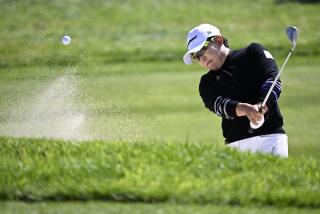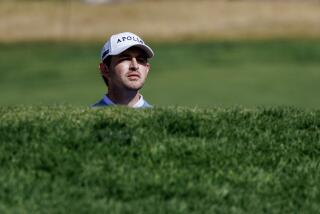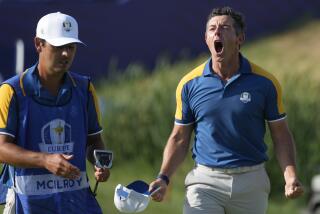THE RYDER CUP
- Share via
The Ryder Cup, competition between a team from the United States and one from Europe, will be played Friday through Sunday at Kiawah Island, S.C. CUP HISTORY
Playing every other year, the competition began in 1927, featuring a team from the United States against one from Great Britain. In 1979, the British side was expanded to include European players. The United States dominated before 1985, winning all but three of the competitions. But Europe won at the Belfry in England in 1985, at Muirfield Village in Ohio in ‘87, and held the Cup in 1989 when the Americans’ collapse on the 18th hole at the Belfry left the teams tied at 14-14. Overall, the U.S. leads, 21-5, with two ties. PLAYING FOR THE CUP
The format is match play. There are eight matches involving two-man teams each of the first two days. In half of those matches, players alternate shots; the other half of the matches is better-ball competition. On the third day, there are 12 singles matches. Each match is worth a point; the team finishing with the majority of the 28 available points is the winner. THE 17TH HOLE
For matches that get that far, the 17th hole could be pivotal. It is a par three that plays from 197 to 215 yards, played with middle to long irons, depending on the wind. There is water to the right and front of the green. A large, deep bunker and a swale guard the left side. THE TEAMS
Each team has 12 players and a nonplaying captain. The top nine Europeans and top 10 Americans qualified for the team by accumulating points since the beginning of 1989. The European captain, Bernard Gallacher, selected three additional players; the U.S. captain, Dave Stockton, selected two.
EUROPEAN TEAM
Number of Record in Cup times on Cup matches Name Age team (won-lost-halved) Seve Ballesteros 34 5 13-8-4 Paul Broadhurst 26 First appearance Nick Faldo 34 7 16-9-2 David Feherty 32 First appearance David Gilford 25 First appearance Mark James 37 4 5-8-1 Bernhard Langer 34 5 10-8-4 Colin Montgomerie 28 First appearance Jose-Maria Olazabal 25 2 7-2-1 Steven Richardson 25 First appearance Sam Torrance 38 5 4-10-4 Ian Woosnam 33 4 7-7-3 Captain: Bernard Gallacher 42 8 13-13-5
AMERICAN TEAM
Number of Record in Cup times on Cup matches Name Age team (won-lost-halved) Paul Azinger 31 1 3-1-0 Chip Beck 35 1 3-0-1 Mark Calcavecchia 31 2 3-4-0 Fred Couples 31 1 0-2-0 Raymond Floyd 49 6 7-13-3 Hale Irwin 46 4 11-4-1 Wayne Levi 38 First appearance Mark O’Meara 34 2 1-4-0 Steve Pate 30 First appearance Corey Pavin 31 First appearance Payne Stewart 34 2 3-5-0 Lanny Wadkins 31 6 15-9-1 Captain: Dave Stockton 49 1 3-1-1
THE COURSE
Pete Dye designed the Ocean Course on Kiawah Island, off the coast of South Carolina. Although similar to the links courses of Great Britian, the Ocean Course differs in a couple of ways. It has Bermuda grass, which tends to grab the ball more than the bentgrass of traditional links courses. That means players won’t be able to play the bump-and-run shots that are a staple of links play. Also, more than a million cubic yards of sand and soil were moved, essentially to raise the course so that the ocean could be seen over the sand dunes. Traditional links courses are laid over a natural stretch of coastland. Also, with much of the 7,304-yard course played through marshlands, it can resemble more of a subtropical layout than a links course. One similarity: Wind could be a major factor. The course has wide fairways but little rough, the fairways ending abruptly in the marshes or dunes.
Scorecard 1. Par 4: 381 yards 2. Par 5: 531 yards 3. Par 4: 370 yards 4. Par 4: 453 yards 5. Par 3: 185 yards 6. Par 4: 544 yards 7. Par 5: 537 yards 8. Par 3: 175 yards 9. Par 4: 464 yards Par 36: Out 3,551 10. Par 4: 406 yards 11. Par 5: 576 yards 12. Par 4: 466 yards 13. Par 4: 404 yards 14. Par 3: 219 yards 15. Par 4: 468 yards 16. Par 5: 579 yards 17. Par 3: 197 yards 18. Par 4: 438 yards Par 36: In 3,753 Total: Par 72 Yardage 7,304
More to Read
Go beyond the scoreboard
Get the latest on L.A.'s teams in the daily Sports Report newsletter.
You may occasionally receive promotional content from the Los Angeles Times.










